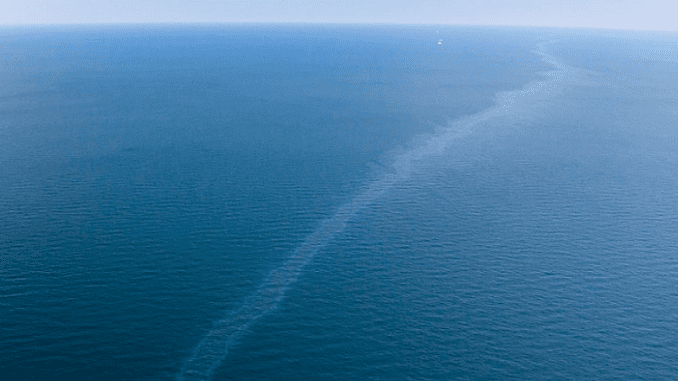
NEW ORLEANS, Louisiana, January 3, 2022 (ENS) – A Louisiana oil and gas company, has agreed to turn over all its remaining assets to the United States to resolve its liability for an oil spill at its former Gulf of Mexico offshore oil production facility – the source of the longest-running oil spill in U.S. history, ongoing for 17 years.
The spill began in 2004, when a Taylor Energy Company production platform located in the Gulf of Mexico about 10 miles off the coast of Louisiana collapsed during Hurricane Ivan, resulting in an ongoing oil discharge that continues to this day.
Taylor Energy exists today solely to address this incident. In 2008, the company sold all of its oil and gas assets and entered into a contract with the U.S. government under which Taylor Energy funded a Trust with $666 million to secure the performance of specific well and facility decommissioning obligations at the site of the so-called MC-20 incident.
Separate from the Trust, the company continues to fund Response efforts, including monitoring by overflights, conducting comprehensive scientific studies of site conditions, making response assets ready for deployment and constructing containment domes located onshore for deployment if needed.
Since April 2019, the vast majority of the leaking oil has been captured by a containment system installed and operated by the U.S. Coast Guard through a contractor.
“For the last three years, the Coast Guard, along with our federal partners, have committed to the challenging mission of containing and removing more than 800,000 gallons of oil discharging into the Gulf of Mexico,” said Sector Commander of the Coast Guard New Orleans Captain Will Watson. “Containment and removal operations continue to this day.”
Under the consent decree proposed by the Justice Department on December 22, Taylor Energy Company LLC will transfer to the Department of the Interior a $432 million trust fund dedicated to plugging the subsea oil wells, permanently decommissioning the facility, and remediating contaminated soil.
The consent decree requires Taylor Energy to pay over $43 million for civil penalties, removal costs and natural resource damages, NRD. The State of Louisiana is a co-trustee for natural resources impacted by the spill and the NRD money is a joint recovery by the federal and state trustees.
“Despite being a catalyst for beneficial environmental technological innovation, the damage to our ecosystem caused by this 17-year-old oil spill is unacceptable,” said U.S. Attorney Duane Evans for the Eastern District of Louisiana.
“We are proud of and grateful to the outstanding interagency team of technical and legal experts from the Departments of the Interior and Justice, the U.S. Coast Guard and other agencies who have worked tirelessly for more than a decade to mitigate environmental impacts to the Gulf of Mexico ecosystem, hold the company accountable, and protect the American taxpayer,” said Deputy Secretary of the Interior Tommy Beaudreau.
The United States filed a civil complaint against Taylor Energy in the U.S. District Court in New Orleans on October 23, 2020 seeking removal costs, civil penalties and NRD under the Oil Pollution and Clean Water Acts arising from the discharge of oil from the company’s former oil production facility.
Between 2016 and 2020, Taylor Energy filed several lawsuits against the United States, including challenging the Coast Guard’s decision to install a spill containment system and appealing the Coast Guard’s denial of Taylor Energy’s $353 million spill-cost reimbursement claim submitted to the U.S. Oil Spill Liability Trust Fund.
The settlement resolves the United States’ environmental enforcement claims against Taylor Energy and requires the company to drop its remaining lawsuits against the United States.
“Offshore operators cannot allow oil to spill into our nation’s waters,” said Assistant Attorney General Todd Kim for the Justice Department’s Environment and Natural Resources Division. “If an oil spill occurs, the responsible party must cooperate with the government to timely address the problem and pay for the cleanup. Holding offshore operators to account is vital to protecting our environment and ensuring a level industry playing field.”
Capt. Watson said, “This settlement will provide significant financial resources for the Bureau of Safety and Environmental Enforcement, Bureau of Ocean Energy Management, National Oceanic and Atmospheric Administration (NOAA) and the Coast Guard to permanently secure the wells, protect the marine environment, preserve marine resources and ensure compliance with the Oil Pollution Act of 1990.”
“This settlement represents an important down payment to address impacts from the longest-running oil spill in U.S. history,” said Nicole LeBoeuf, Director of NOAA’s National Ocean Service. “Millions of Americans along the Gulf Coast depend on healthy coastal ecosystems. NOAA and our co-trustees look forward to working in partnership with the National Pollution Funds Center to ensure the region and the ecosystem can recover from this ongoing tragedy.”
The settlement was filed as a proposed consent decree and is subject to a 40-day public comment period and court review and approval. A copy of the consent decree is available on the Department of Justice website at www.justice.gov/enrd/Consent_Decrees.html.
Featured image: Taylor Energy Oil Spill leaves a streak across the Gulf of Mexico, September 10, 2012 (Photo by Dubinsky Photography for LMRK.org. Flight provided by Southwings.org, used with permission of Louisiana Environmental Action Network)



